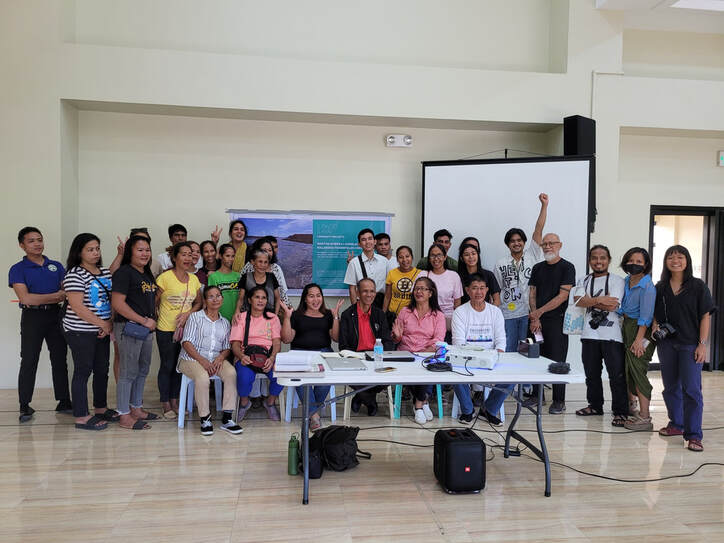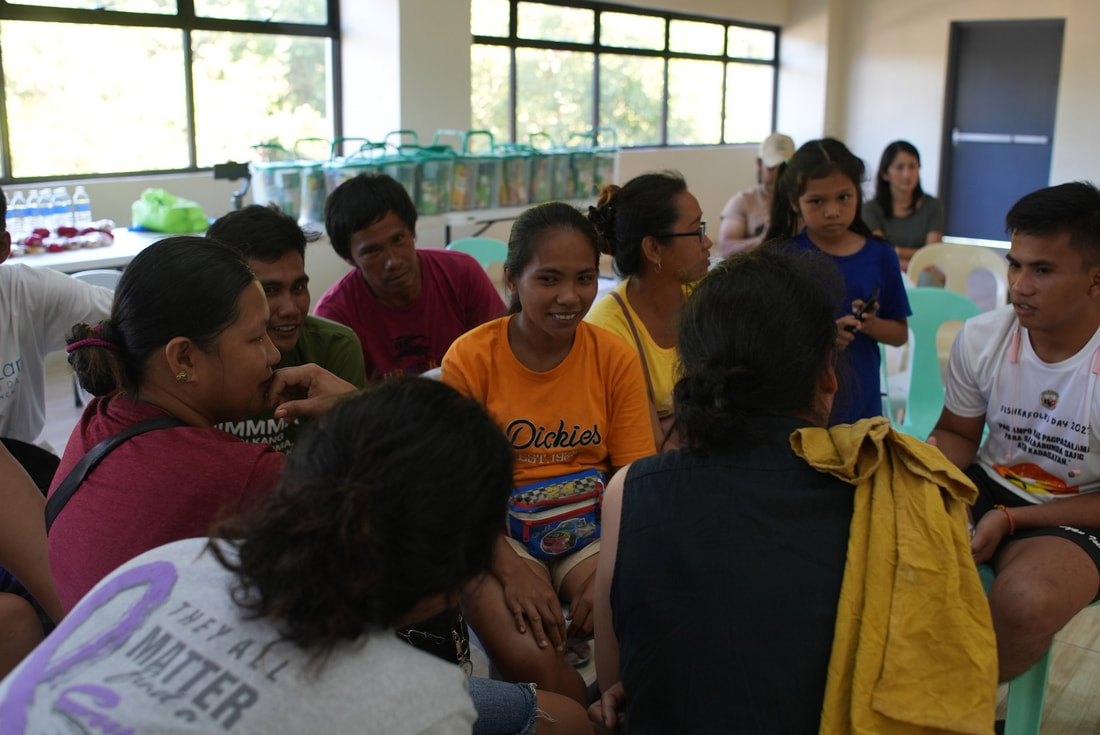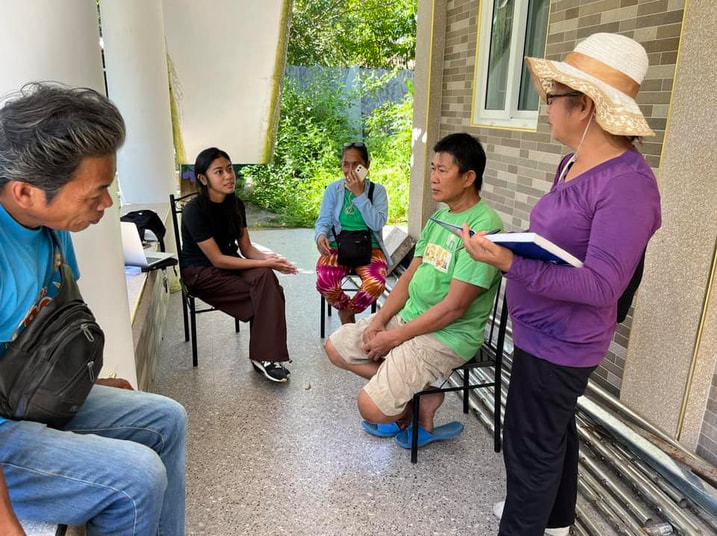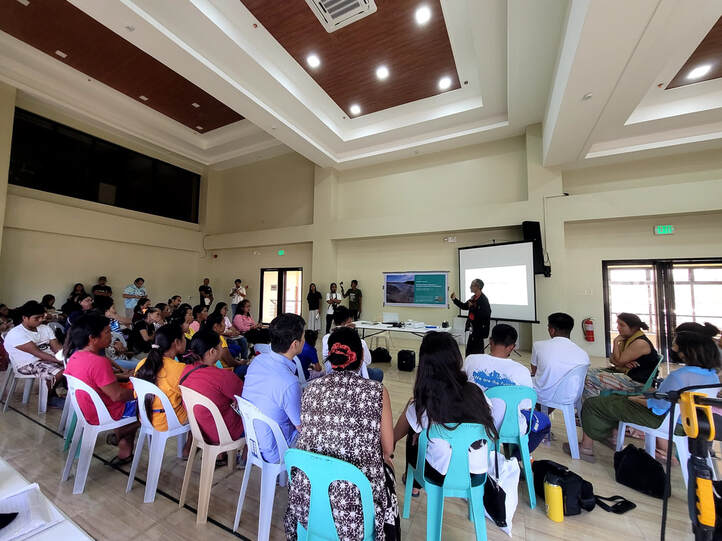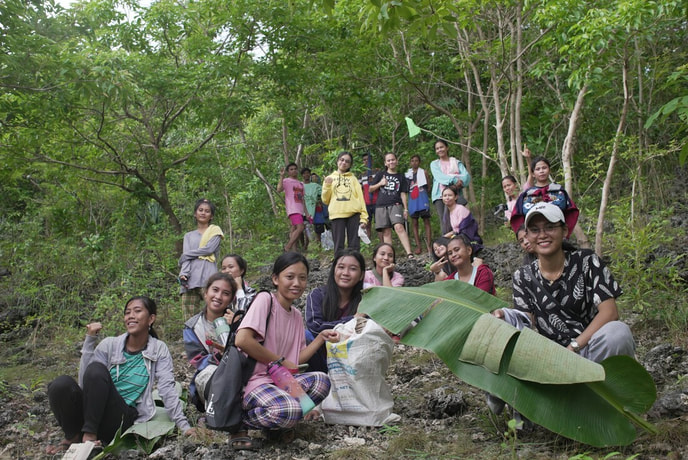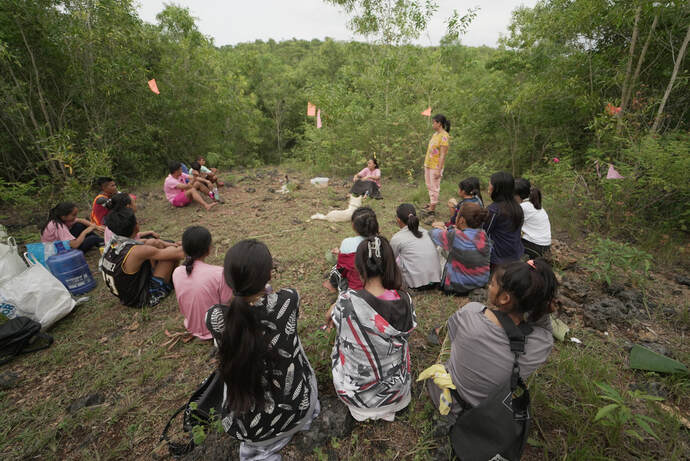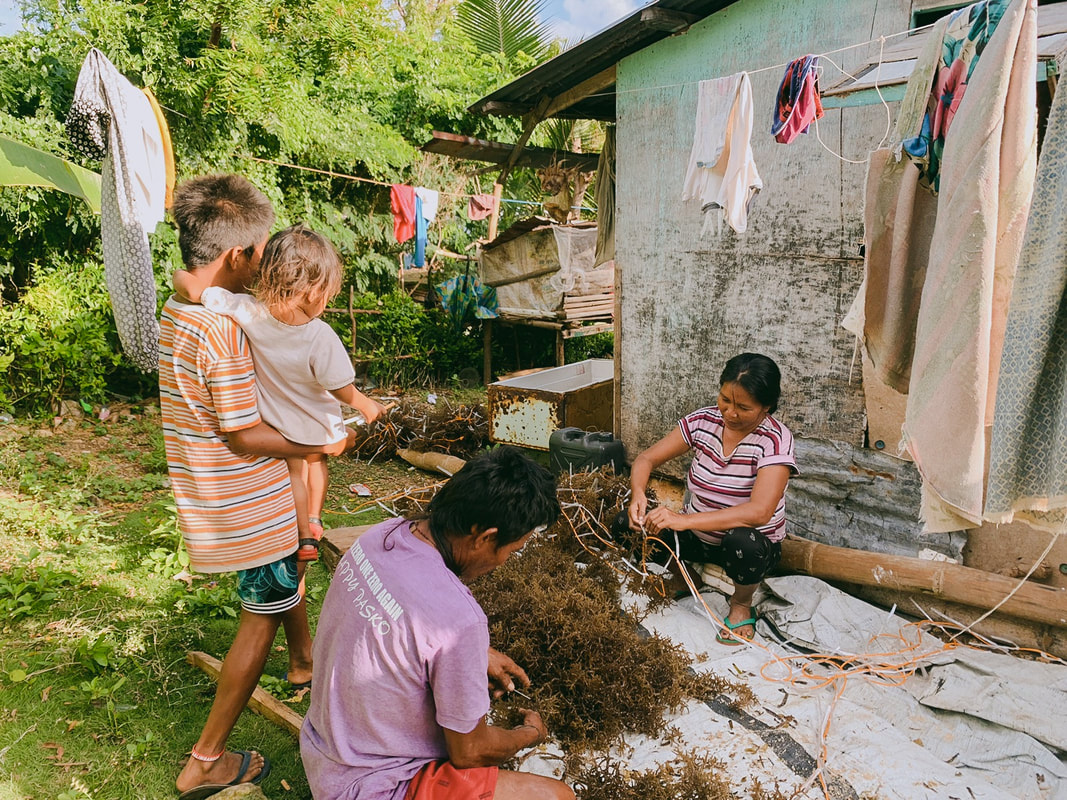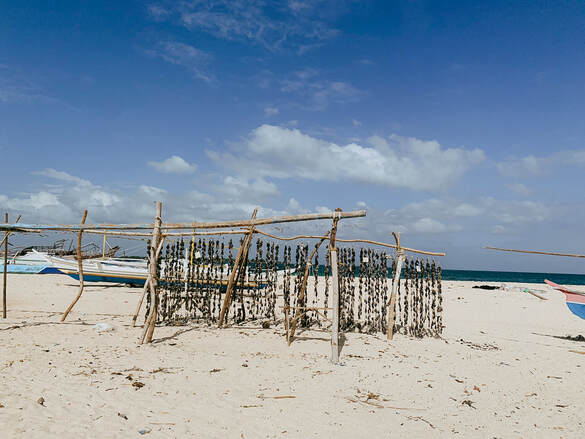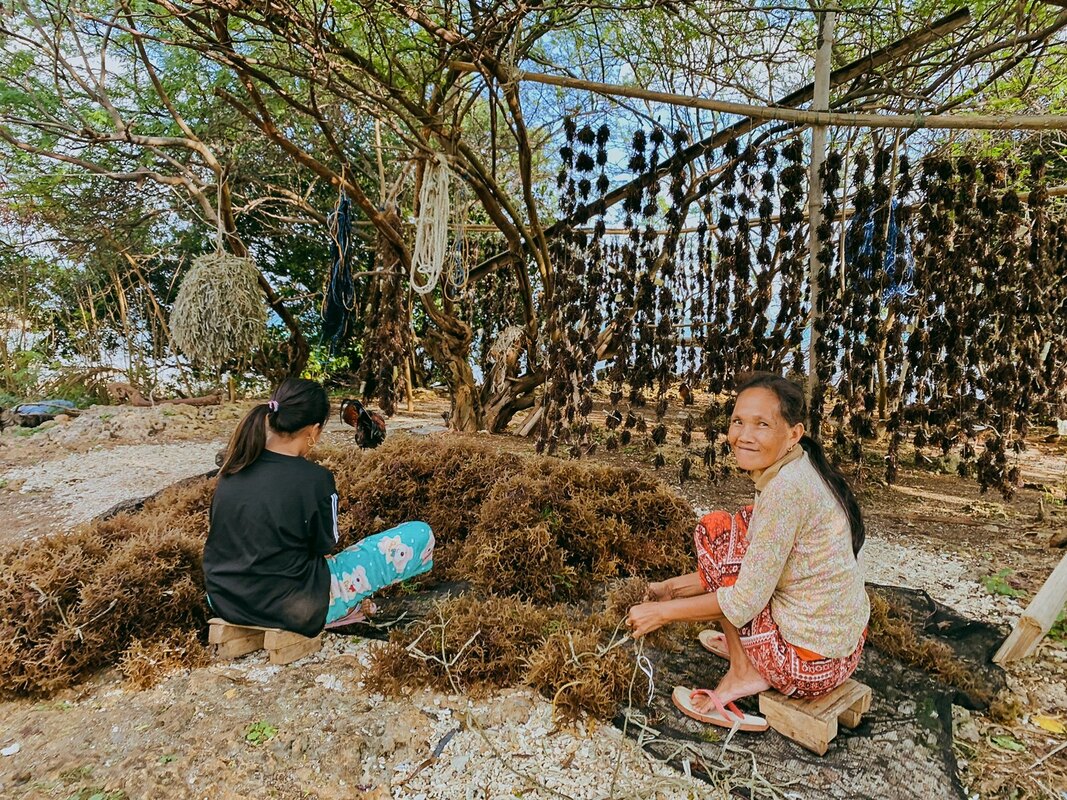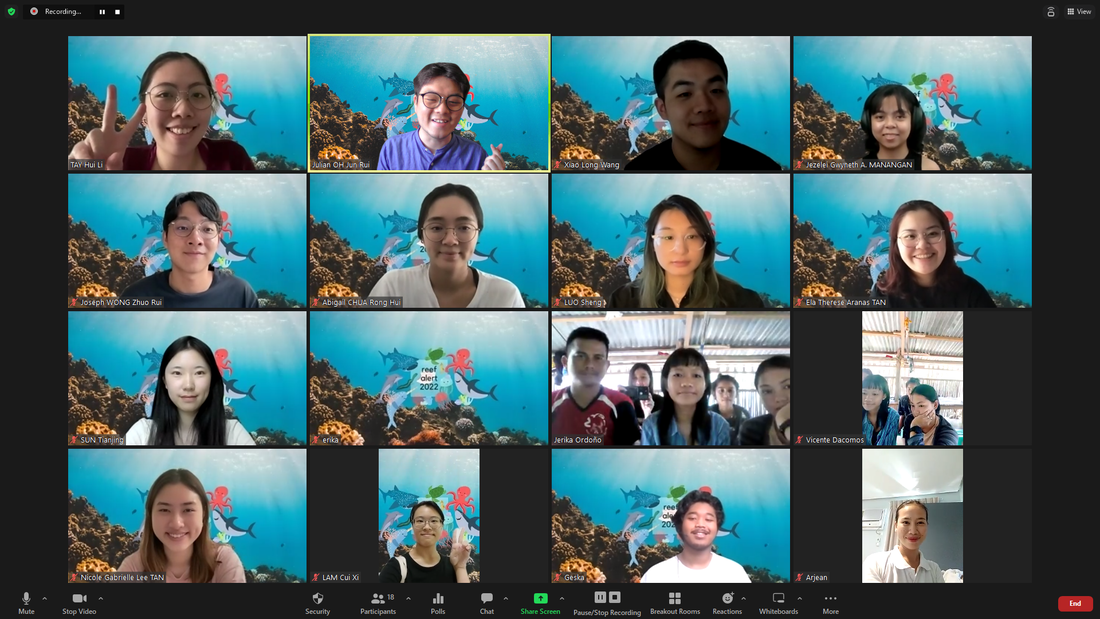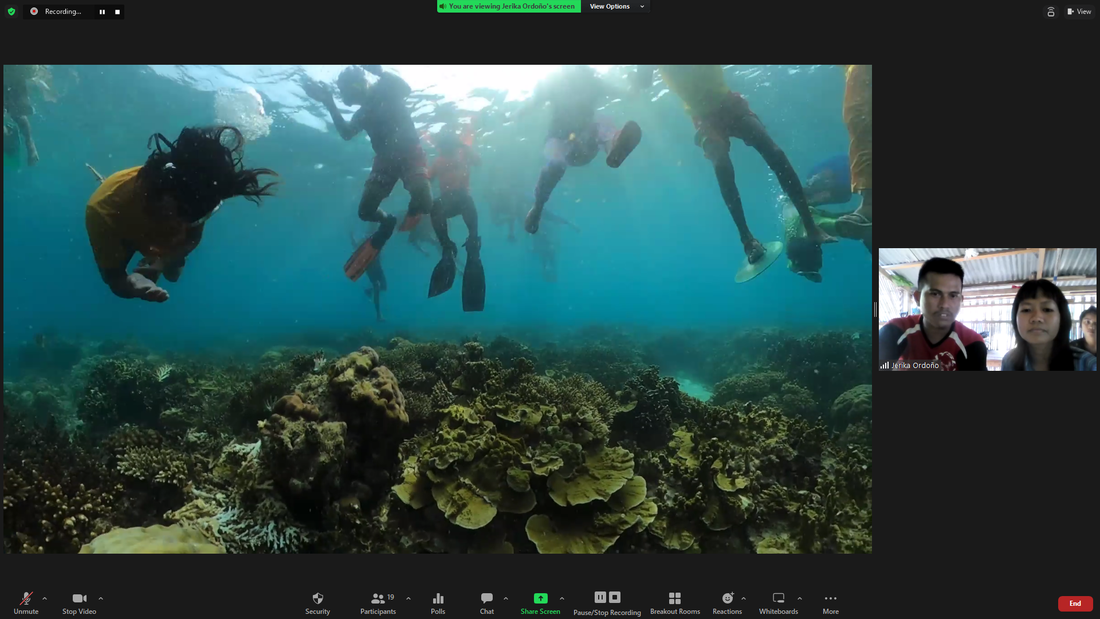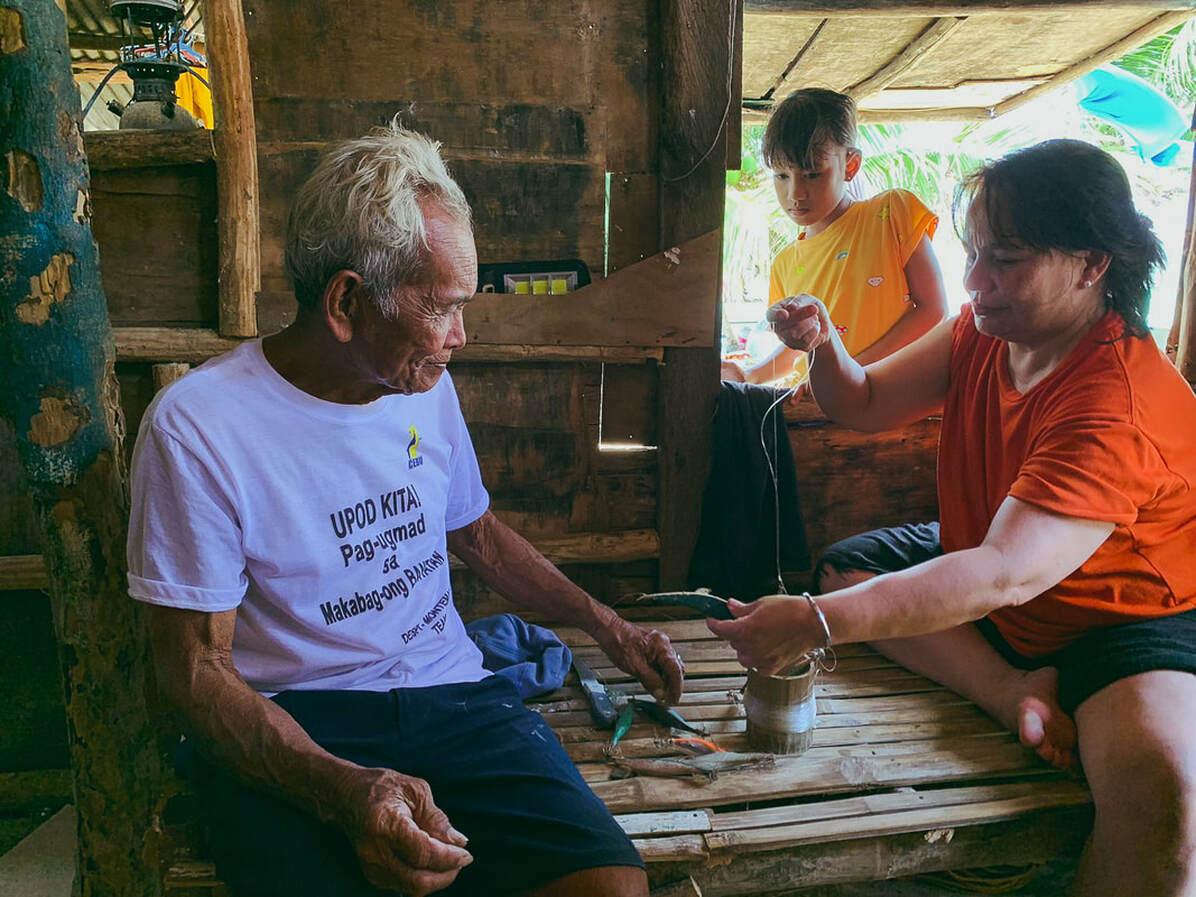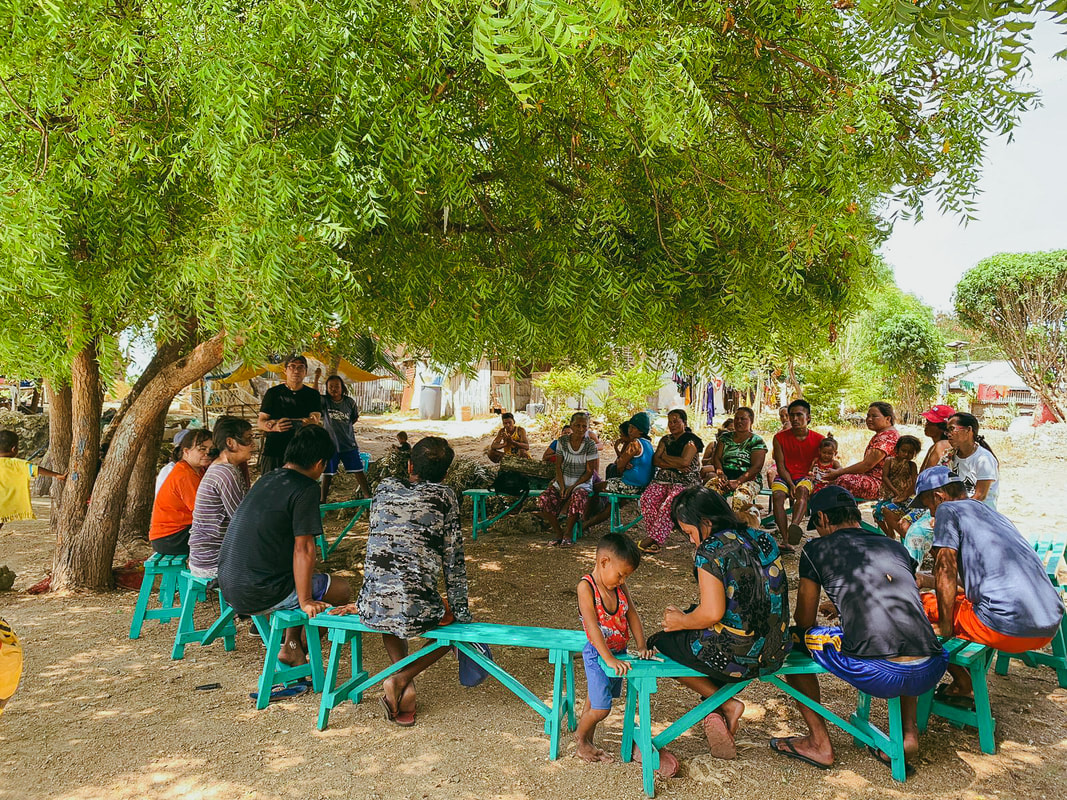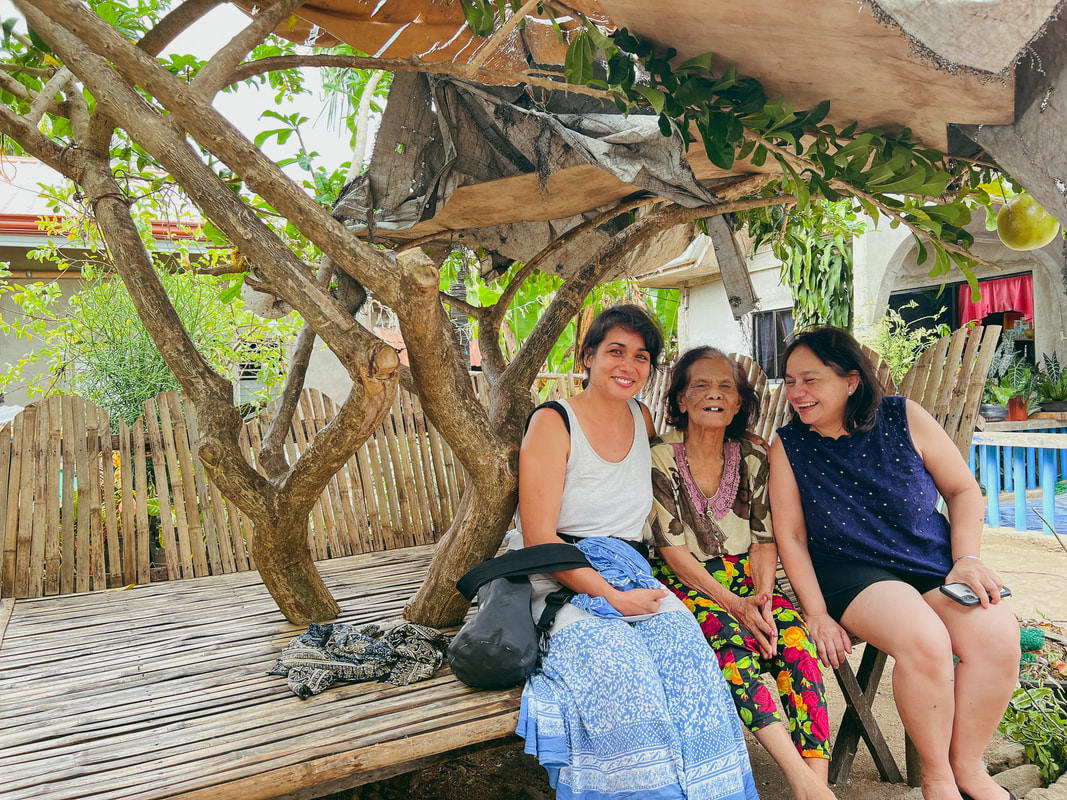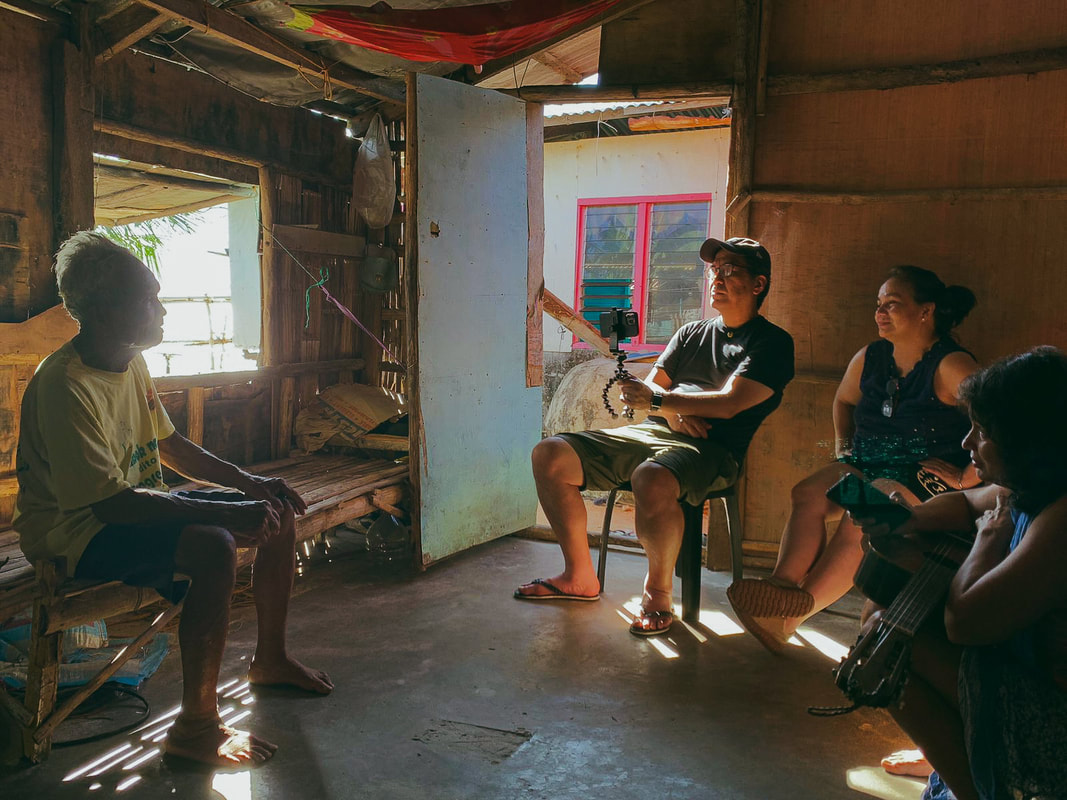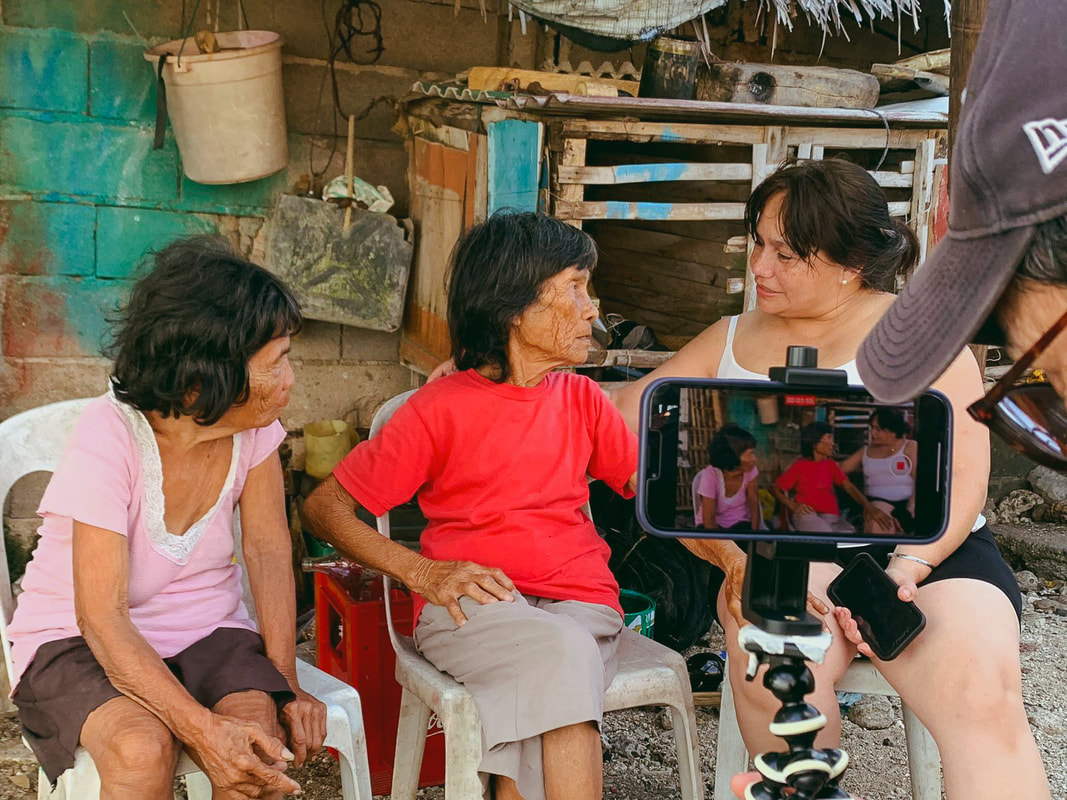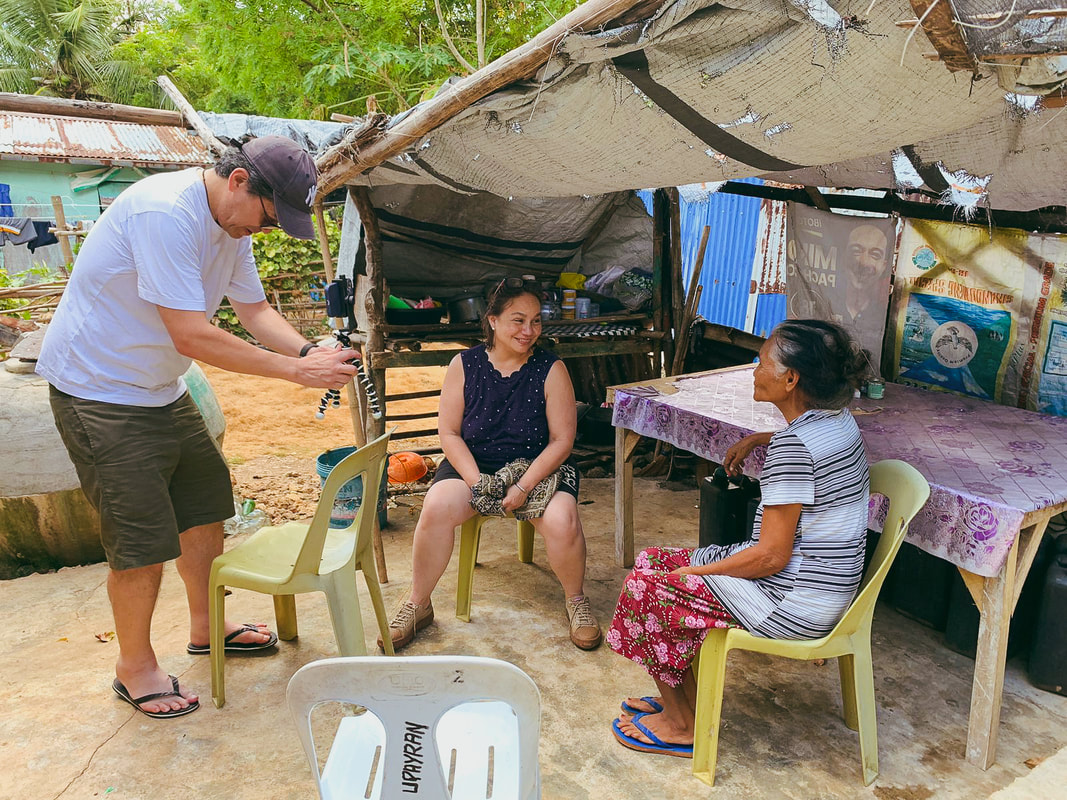ILAWOD, ILAYA Community Projects
How can we harness the practical impact of art in real-world contexts?
|
Addressing this challenge raises questions about how platforms like VivaExcon can serve as inclusive spaces for our marginalized farmers and fisherfolks. It prompts us to explore avenues for amplifying their voices while forging connections and collaborations among fisherfolk, local government units (LGUs), and various organizations and institutions.
It prompts a fundamental question: In what ways can art facilitate a convergence of perspectives and actions, paving the way for constructive and valuable partnerships? Recognized as the Philippines' biggest and longest-running art biennale, VIVA ExCon stands as a unique coming together of artists aimed at spotlighting the rich culture of the Visayas region. This event encompasses an art exhibition, forums, lectures, meetings, roundtable discussions, outdoor installations, and public performances, making it an unparalleled celebration of artistic expression and cultural representation. Our recent participation in ILAWOD, ILAYA Community Projects as part of this year’s 17th Viva Excon held at the DENR-Penro building along Malandog River in Antique, facilitated an open dialogue and provided a platform for the voices of fisherfolk communities across diverse Visayan islands. It allowed these communities to collectively address and discuss the challenges they share. Meeting the Malandog Fisherfolks along with various stakeholders, fisherfolk representatives, and leaders created a space for these narratives, forming dialogues about coastal challenges. An open forum followed to discuss and to share stories beyond the surface of events and allowing an understanding of the fisherfolk's realities. This resonated with GOODLand’s commitment to uniting communities and advocating for policies that safeguard the environment and natural resources through purposeful collaborations with Local Government Units. The participation of the youth was an important aspect of these dialogues, with students from Cebu Technical University—Emman John Jamili and Aldrin Dacumos—alongside Peter Jamili, a youth from Mambacayao Dako, and Roxanne Carano-o from Madridejos Community College. They shared their own experiences as young individuals in Bantayan Island, actively advocating for their lands and the environment. They used their voices to be an example of the interconnectedness of generations in the collective effort to navigate the complexities of coastal living. Rowel L Saldajeno Jr., currently a BS Fisheries student from University Of Antique youth representative from Malandog, son of Rowel Saldajeno who is a Fisherfolk leader, added his perspective to the dialogue. The convergence of diverse voices in this setting showed how art can transcend its traditional role and become a space for collaboration. By situating this event within the context of VivaExcon, it becomes evident that art platforms can serve as dynamic arenas where meaningful connections between marginalized communities, government entities, and organizations are forged, contributing to the realization of valuable collaborations on the ground.
|
As we move forward, the stories shared and the connections forged in ILAWOD and ILAYA stand as a testament to the power of collaboration, understanding, and collective action. GOODLand remains steadfast in its dedication to uniting communities, advocating for policies, and ensuring a coexistence with the environment where communities thrive. The echoes of these dialogues will continue to guide our efforts, inspiring positive change for the well-being of coastal communities across the Visayan islands.
Special thanks and appreciation go to the following individuals for their contributions to ILAWOD, ILAYA Community Projects, an initiative of Green Papaya Art Projects: The ILAWOD, ILAYA Community Projects was initiated through the efforts of Giah De los Reyes, its program director, as a result of her coordination with GOODLand in Bantayan island, and fieldwork in Guimaras island, Barangay Odiong in Sibalom and in the Malandog fishing community in Antique. The convergence of the Bantayan and Malandog fishing communities, a VIVA ExCon Antique 2023 community program was organized and moderated by her. Bryan Liao: Festival Director of VIVA ExCon Antique 2023. His support plays a crucial role in the success of this initiative. We express our gratitude to everyone involved for their commitment and support in making ILAWOD, ILAYA Community Projects a reality. SUBA SA IRAYA: The 17th edition of Viva ExCon, with the theme "Crosscurrent" (or "Counterflow"), marks a significant shift in the cultural landscape. For the very first time, the 17th Edition of Viva ExCon graces Antique with its presence, weaving a tapestry of artistic expression and innovation against the backdrop of this culturally rich province. "Crosscurrent" invites participants and attendees to explore the convergence of diverse artistic currents and dynamic dialogue that transcends and pushes the boundaries of creative exploration. #VIVAExConAntique2023 #VIVAExConSubaSaIraya #VIVAExCon17 To learn more about VIVA ExCon Antique 2023, head over to their website: The Bantayan Group of Islands is located between the Visayan Sea and the Tanon Straight in the center of the Philippines. This archipelago is divided into three separate municipalities. The islanders mainly depend on the sea for their livelihood, thus these islands consist of many coastal fishing communities. |
Bihiya Summer Workshop 2023
Vertical Divider
Bihiya Warriors completed a three-day Summer Workshop with Goodland’s Mambacayao Youth Branch, centered around the theme "Ila-Ilaha ang Bihiya".
Day 1
Over the past month, the Bihiya Warriors dedicated themselves to preparing for this workshop, and it proved to be worth every effort. The three-day program was packed with activities and meaningful interactions. Moreover, this workshop also provided an opportunity for the girls to share the hard work and efforts they have been undertaking in their land, including mapping the watershed, identifying plant and tree species, and learning more about their own culture and oral histories by interviewing the older people of Bihiya.
On the first day, the members of the Mambacayao Youth Branch, young people from the watershed area, along with two students from CTU taking their bachelor’s degree in Fisheries and who gracious enough to accept our invitation, arrived greeted with warm smiles and a handmade garland made out of local materials (Coconut leaves). The day kicked off with a friendly introduction, allowing everyone to get to know each other better. The workshop's first activity, "Ila-ilahon ang Kaugalingon," proved to be a fun ice-breaker experience. As participants compared themselves to elements of nature, they gained new insights into their own identities and their interconnectedness with the world around them. Some of the participants likened themselves to flowers, fruits, and natural landscape formations. The day drew to a close with documentary showing and the participants left the day feeling inspired and excited for the upcoming two days of the workshop.
The Bihiya Warriors is a group of young people residing in Bihiya (Sitio 37), barangay Atop-atop. The name "Bihiya" has been passed down by their ancestors, symbolizing the significance of their settlement in the heart of Bantayan Island, where the island's deepest well is located. “Together with Goodland and our fellow youth volunteers, we strive to create a powerful collective voice that advocates for the protection of our environment, the sustainable management of our resources, and the preservation of our identity. We stand united in our commitment to building a brighter, greener future for all, guided by the belief that our actions today will shape the world we inherit tomorrow.”
On the first day, the members of the Mambacayao Youth Branch, young people from the watershed area, along with two students from CTU taking their bachelor’s degree in Fisheries and who gracious enough to accept our invitation, arrived greeted with warm smiles and a handmade garland made out of local materials (Coconut leaves). The day kicked off with a friendly introduction, allowing everyone to get to know each other better. The workshop's first activity, "Ila-ilahon ang Kaugalingon," proved to be a fun ice-breaker experience. As participants compared themselves to elements of nature, they gained new insights into their own identities and their interconnectedness with the world around them. Some of the participants likened themselves to flowers, fruits, and natural landscape formations. The day drew to a close with documentary showing and the participants left the day feeling inspired and excited for the upcoming two days of the workshop.
The Bihiya Warriors is a group of young people residing in Bihiya (Sitio 37), barangay Atop-atop. The name "Bihiya" has been passed down by their ancestors, symbolizing the significance of their settlement in the heart of Bantayan Island, where the island's deepest well is located. “Together with Goodland and our fellow youth volunteers, we strive to create a powerful collective voice that advocates for the protection of our environment, the sustainable management of our resources, and the preservation of our identity. We stand united in our commitment to building a brighter, greener future for all, guided by the belief that our actions today will shape the world we inherit tomorrow.”
Day 2: Roots and Routes
On the second day of the Bihiya Warriors Summer Workshop, the participants embarked on the main activity for the day which is called “Roots and Routes”, an educational hike through the forests and farming households in the watershed area. The group set out to explore the connection between the environment and the people who inhabit it. Guided by members of the Bihiya Warriors, the morning commenced with meditation and stretching in preparation for the day ahead. Lunch followed and they were ready for the next activity. The participants joined in a fun activity to show how watersheds work in nature. They were given crumpled paper, markers, pens, and a spray bottle. They were told to crumple the paper and draw on it with colors and symbols. Each crumpled paper showed something special about the environment – like forests, fields, towns, and water. Using the markers and pens, they drew trees, houses, and rivers on the paper.
They used the spray bottle to pretend it was raining, gently misting the crumpled paper. As the drops fell, they joined together, making tiny streams that flowed through the paper's folds and formed small rivers in the pool. At that moment, the group got the idea of how watersheds work. They saw how the land's shape guides water, collecting it from different places and leading it to the center – the pool. Just like in nature, this showed how important watersheds are – they gather and share water.
This activity was like a special picture that showed how everything in the environment – like forests, fields, houses, and water – is connected. It taught them that everything needs to be in balance, and watersheds help make that happen.
During the hike, the participants also had the opportunity to visit some homes of local residents in the area. They also got to experience the abundance of fruit-bearing trees that grew wild in Bihiya.
The initial phase of the walk led to the Bihiya cave which is home to some unidentified local trees from the area. Additionally, the group also delved into the traditional agricultural practices that have sustained the community for ages. The bukid, or farmland, served not only as a source of nourishment but also as a living testament to ancestral farming methods that harmonize with the land.
Continuing along the hike's path, a remarkable sight emerged – the "Basyaw." These natural stone formations served as catchments for water during the rainy season. For the Bihiya Warriors and their neighboring friends, the "Basyaw" held a deep nostalgic value from their childhood. While the formations provided a source of water for grazing cows, they also transformed into a playful mini pool during other periods. The culmination of the hiking experience was marked by an activity called "Deep Into Nature." This segment served as a grounding exercise, encouraging participants to heighten their sensory awareness. They were guided to close their eyes and, in doing so, open themselves to their surroundings. The rustling of leaves in the breeze, the melodious songs of birds echoing through the air, and the caress of the wind against their skin became more vivid. This exercise facilitated a profound connection to the natural world, allowing the participants to momentarily detach from their usual perceptions and fully immerse themselves in the present moment. In this way, the "Deep Into Nature" activity was a symbolic embodiment of the entire educational walk’s purpose – to foster a deeper connection between individuals and the environment that sustains them. By encouraging participants to listen, feel, and be fully present in the moment, the activity served as a poignant reminder of the symbiotic relationship between humans and their surroundings.
This packed but fulfilling day presented a rich opportunity for the island youth to connect with their counterparts from the watershed. Despite originating from diverse backgrounds and growing up in distinct surroundings, this educational walk served as a medium for these separate groups to discover mutual understanding and create relationships that went beyond their variations.
Day 3: Exploring Tabay and Sharing Culture
On the concluding day of the Bihiya Warriors Summer Workshop, participants embarked on a day that further deepened their understanding of the watershed area's significance and the lives of those who call it home. This last day of the summer camp was dedicated to connecting with local households, appreciating the heart of the area, and immersing themselves in the cultural tapestry woven by its inhabitants. The day commenced with a sense of curiosity and anticipation as the Bihiya Warriors, armed with the insights they had gathered over the course of their stay, shared the outcomes of their interview to the youth of Mambacayao Dako. These interviews captured moments of triumph and challenges overcome, weaving together a vibrant narrative of the community's collective memory. Elder residents shared stories of their youth, offering a glimpse into how the landscape has transformed, and how the community has adapted and thrived amidst changes. The oral histories, passed down through generations, painted a vivid picture of the struggles, triumphs, and values that have been handed down as an enduring legacy. From tales of shared joys during festivals to accounts of overcoming adversities brought about by environmental shifts, these interviews wove a tapestry of stories that showcased the interconnectedness of the people and their surroundings.
Through these conversations, the community's history came alive, showcasing the resilience, values, and experiences that had shaped the area's identity over time. The participants set out to explore the lives of people living around the watershed area. Visiting these households provided an opportunity to witness firsthand the close relationship between the environment and the community. The residents generously welcomed the participants, sharing stories and insights about their daily lives, their connection to the land, and the challenges they face. They had the privilege of meeting Lola Siting, a local resident. Lola Siting shared her heart and soul through her original songs that resonated with life's joys, struggles, and the love she had for her children. One of the highlights of the day was the visit to "Tabay," the very heart of the area. This well served as a vital part of the community, providing the essential water supply to Bihiya. Here, the participants could witness the importance of water and its role in sustaining not only individual lives but the entire ecosystem. The group engaged in discussions about water conservation, local practices, and the interconnectedness of resources.
The Bihiya Warriors Summer Workshop concluded with a closing ceremony that celebrated the newfound friendships, the knowledge gained, and the commitments made to protect the environment. Participants shared their program experiences, reflecting on the impact the summer camp had on them. They sang songs and shared laughter. Following this heartwarming gathering was a fun game wherein participants showcased their ability to identify indigenous trees, showing what they learned during their hikes.
As we bid farewell to this memorable journey, we recognize that it's not just an end but a new beginning. The legacy of this workshop extends beyond its closing ceremony, thriving within the participants, the Bihiya Warriors, and the entire community. It is a testament to the power of collective action, understanding, and advocacy in our ongoing commitment to protect and cherish the environment. The seeds planted during this camp will continue to grow, fostering a brighter, more sustainable future for all.
Through these conversations, the community's history came alive, showcasing the resilience, values, and experiences that had shaped the area's identity over time. The participants set out to explore the lives of people living around the watershed area. Visiting these households provided an opportunity to witness firsthand the close relationship between the environment and the community. The residents generously welcomed the participants, sharing stories and insights about their daily lives, their connection to the land, and the challenges they face. They had the privilege of meeting Lola Siting, a local resident. Lola Siting shared her heart and soul through her original songs that resonated with life's joys, struggles, and the love she had for her children. One of the highlights of the day was the visit to "Tabay," the very heart of the area. This well served as a vital part of the community, providing the essential water supply to Bihiya. Here, the participants could witness the importance of water and its role in sustaining not only individual lives but the entire ecosystem. The group engaged in discussions about water conservation, local practices, and the interconnectedness of resources.
The Bihiya Warriors Summer Workshop concluded with a closing ceremony that celebrated the newfound friendships, the knowledge gained, and the commitments made to protect the environment. Participants shared their program experiences, reflecting on the impact the summer camp had on them. They sang songs and shared laughter. Following this heartwarming gathering was a fun game wherein participants showcased their ability to identify indigenous trees, showing what they learned during their hikes.
As we bid farewell to this memorable journey, we recognize that it's not just an end but a new beginning. The legacy of this workshop extends beyond its closing ceremony, thriving within the participants, the Bihiya Warriors, and the entire community. It is a testament to the power of collective action, understanding, and advocacy in our ongoing commitment to protect and cherish the environment. The seeds planted during this camp will continue to grow, fostering a brighter, more sustainable future for all.
Seaweed Farming in the Community of Mambacayao DakoFor the people of Mambacayao Dako, this is how their typical weekend looks like.Mambacayao Dako is a coastal islet administered under Barangay Lipayran of the municipality of Bantayan, located in the Doong group of islands, southwest of Bantayan Island in the Philippines. It is home to a diverse community of people who are primarily engaged in agriculture and fishing. Seaweed farming is one of the main sources of livelihood in this barangay, providing income and employment opportunities to many of its residents.
Seaweed farming in Mambacayao Dako began in the 1980s, when a group of local farmers started to cultivate 'Eucheuma Cottonii', particularly known as "gusô", a type of seaweed that may vary in color (red, brown, and green) is commonly used in the production of carrageenan, a food additive and thickener. The farmers initially started with small-scale seaweed cultivation using only bamboo poles and ropes to anchor the seaweed to the sea floor. Over time, the practice evolved and became more sophisticated, with the use of nylon ropes and other materials to improve yields. TODAY, SEAWEED FARMING IN THE ISLAND IS A THRIVING INDUSTRY, WITH MORE OR LESS 70 OUT OF 87 HOUSEHOLDS ENGAGING IN SEAWEED FARMING. The farmers cultivate their seaweed in floating seaweed nurseries, which are made up of bamboo rafts and nets that are anchored to the sea floor. The seaweed is grown for around 45 days before it is harvested, dried, and sold to middlemen who export it to processing plants in other parts of the country.
Seaweed farming has brought significant economic benefits to Mambacayao Dako, helping to improve the standard of living of many of its residents. It has also provided employment opportunities to both men and women, with many families involved in the industry. Seaweed farming is particularly attractive to women, who are able to work from home and look after their children at the same time. |
Exciting Cultural Exchange with Singapore Management Students Through Project Reef Alert
We had an incredible experience promoting marine conservation and celebrating diverse cultures through a collaborative event! Our joint initiative with SMU students brought together a passion for preserving our oceans and embracing different traditions. The Canva poster design workshop was a success since it allowed the kids to express their creativity and selves through beautiful graphics. We gained a lot of knowledge from one another while producing eye-catching graphics to promote efforts towards marine conservation. We really appreciate Reef Alert's hardworking staff and Vicente Dacomos for making this exchange possible as well as the residents of Mambacayao Dako for kindly receiving us with warmth and participation Together, we are making a positive impact on our planet's precious ecosystems and fostering cultural understanding. As we reflect on this remarkable experience, our hearts are filled with anticipation for future initiatives that will further ignite children's creativity, raise awareness, and cultivate an environment where our collective efforts can flourish.
Localized storytelling of resiliency, livelihood, and unwritten culture in Mambacayao Dako.
|
We have been lucky enough to extend an invitation to Dr. Cristina Martinez-Juan with her husband Mr. Jovi Juan to participate in a cultural immersion on Mambacayao Dako with the objective to study about the island’s history and culture. Dr. Martinez-Juan has worked closely with local communities to document and analyze cultural landscapes through developing sustainable strategies for preserving cultural heritage. She earned a doctorate in Comparative Literature from the University of the Philippines, Diliman, and used to work as an Associate Professor in the Humanities Department at the University of the Philippines, Cebu, before relocating to New York in 1996 and later to London in 2013. In 2017, she led the establishment of Philippine Studies at SOAS (PSS) within the Centre of South East Asian Studies, which serves as a cross-disciplinary platform for teaching, research, and cultural expression related to the Philippines in the UK.
During our visit, we had the opportunity to engage in discussion with the island’s elderly population exploring topics on their way of life, traditional fishing practices, and uncover the unwritten knowledge of its people and the sea. We also learned about the island's traditional fishing practices, which have been passed down from generation to generation. The locals use a unique method of fishing called "panagat" where they use a long line with multiple hooks and bait to catch fish. This method for fishing is both sustainable and adaptable to the constantly evolving sea conditions and current circumstances. The elders discussed how their way of life was being impacted by climate change and the harm caused to the sea. They mentioned that the fish stocks, which used to be plentiful, were now declining, and the coral reefs were deteriorating, making it more challenging for them to earn a living. As a result, they have had to rely considerably on guso farming in times when fish catch is low. They further elaborated on the impact of illegal fishing, explaining how it has contributed to the depletion of marine resources and threatened their way of life. They highlighted how illegal fishing practices devastated the marine ecosystem, making it even harder for them to catch fish and earn a living, harming their family’s livelihoods and the marine environment. IN ADDITION TO THE CHALLENGES POSED BY CLIMATE CHANGE AND ENVIRONMENTAL DEGRADATION, THE ELDERS OF MAMBACAYAO DAKO ALSO EXPRESSED CONCERNS ABOUT THE YOUNGER GENERATION MOVING AWAY FROM THE ISLAND. THEY WORRIED THAT THEIR TRADITIONS AND CULTURAL HERITAGE COULD BE LOST AS THEIR CHILDREN AND GRANDCHILDREN SEEK OPPORTUNITIES ELSEWHERE. Fascinated by the unwritten knowledge and history of Mambacayao that we learned from the elders, they recounted the tales of their forefathers and their arrival on the island, which were shrouded in mystery and fascination. Among the earliest families to settle on the island were the Jamili's, Mangcao's, and Batad's. The island had a rich culture that had been shaped by the people's nomadic roots and their constant movement across the ever-changing sea – all of this is a testament to the resilience and adaptability of their people. In essence, this experience gave us a newfound respect for their traditional way of life. It underscored the importance of safeguarding cultural heritage for the forthcoming generation. It has enhanced our understanding of the significance of cultural heritage in shaping the identity of communities. The value of cultural heritage lies not only in its intrinsic importance to the local community but also in its potential for promoting inter-community dialogue and understanding.
THUS, IT IS ESSENTIAL TO RECOGNIZE AND PRESERVE THE ANCESTRAL LEGACY OF COMMUNITIES, SUCH AS MAMBACAYAO DAKO, TO ENSURE THAT THEIR UNIQUE PERSPECTIVES AND WAY OF LIFE CONTINUE TO THRIVE AND CONTRIBUTE TO THE RICHNESS OF OUR SHARED HUMAN EXPERIENCE. |

